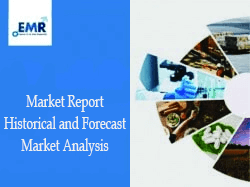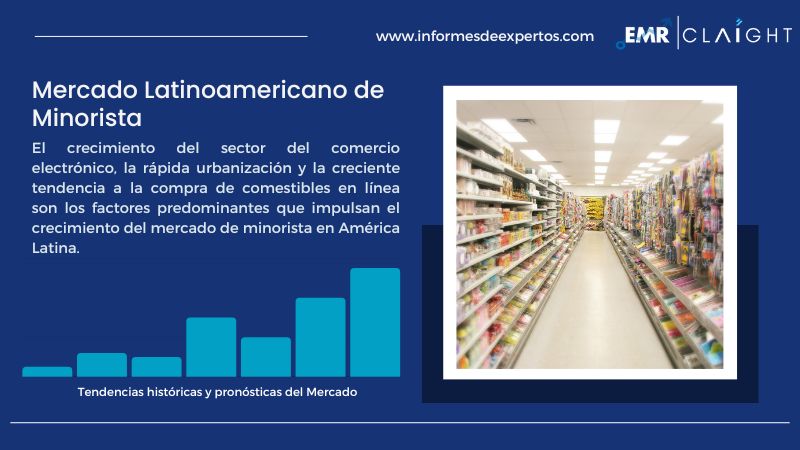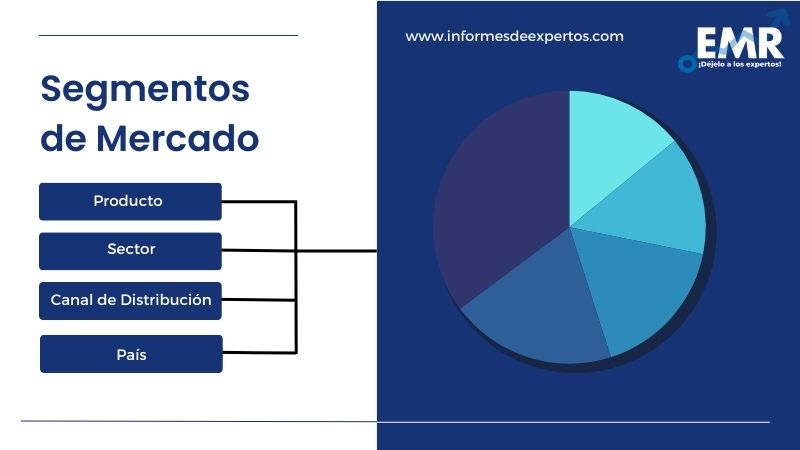Informes

Mercado Latinoamericano de Minorista – Por Producto (Alimentos, Bebidas y Comestibles, Cuidado Personal y del Hogar , Ropa, Calzado y Accesorios, Muebles y Decoración del Hogar, Industria y Automoción, Electrónica y Electrodomésticos, Productos Farmacéuticos, Otros); Por Sector (Organizado, No Organizado); Por Canal de Distribución (Hipermercados y Supermercados, Tiendas de Conveniencia, Tiendas Especializadas, Comercio Electrónico, Otros); Por País (Brasil, México, Argentina, Otros); Dinámica del Mercado y Panorama Competitivo
Perspectiva del Mercado Latinoamericano de Minorista
El mercado latinoamericano de minorista alcanzó un valor de USD 2,38 mil millones en el año 2025. Se estima que el mercado crecerá a una tasa de crecimiento anual compuesta del 2,4% entre 2026 y 2035, para alcanzar un valor de 2,94 mil millones de USD en 2035.
El comercio minorista se refiere al proceso de venta de bienes o servicios a los consumidores a través de varios canales de distribución para satisfacer su demanda. La industria minorista es amplia y está formada por empresas de diversos sectores que incluyen abarrotes, conveniencia, tiendas independientes, grandes almacenes, bricolaje, electricidad y especialidades. Una transacción minorista maneja principalmente pequeñas cantidades de bienes o servicios.

Informe de muestra gratuito con índice: Obtenga un informe de muestra gratuito con tabla de contenido
La venta minorista por Internet se ha convertido en la forma moderna de comprar, lo que está impulsando el crecimiento del mercado latinoamericano de minorista. Gracias a la creciente penetración de Internet, la región de América Latina está emergiendo como un atractivo mercado de comercio electrónico. La pandemia fue un catalizador para el crecimiento del sector del comercio electrónico. Ciertas categorías como comestibles, oficina en casa, tecnología, juguetes, gimnasio en casa y otras cosas esenciales experimentaron un crecimiento masivo durante el período de cuarentena en 2020, mientras que el mercado de lujo y los artículos no esenciales sufrieron una baja en la demanda en comparación con 2019. Los estudios muestran que casi 13 millones de personas en América Latina realizaron una transacción minorista en línea por primera vez en 2020, con un crecimiento significativo en Argentina (79%), Brasil (35%) y México (27%). Esto proliferó el crecimiento del sector minorista.
Además, con la creciente adopción de teléfonos inteligentes y la mayor accesibilidad de los consumidores a los elementos esenciales cotidianos desde la comodidad del hogar, el mercado objetico está aumentando aún más. Además, la creciente popularidad de la realidad aumentada entre los minoristas y los consumidores también está acelerando el crecimiento de la industria, ya que mejora la experiencia del consumidor al permitir a las personas visualizar los artículos seleccionados.

Informe de muestra gratuito con índice: Obtenga un informe de muestra gratuito con tabla de contenido
Sector Minorista: Segmentación del Mercado
Por el producto, el mercado se divide en:
- Alimentos, Bebidas y Comestibles
- Cuidado Personal y del Hogar
- Ropa, Calzado y Accesorios
- Mobiliario y Decoración del Hogar
- Industrial y Automotriz
- Electrónica y Electrodomésticos
- Productos Farmacéuticos
- Otros
Según el sector, el mercado se divide en:
- Organizado
- No Organizado
En función de los canales de distribución, el mercado se segmenta en:
- Hipermercados y Supermercados
- Tiendas de Conveniencia
- Tiendas Especializadas
- Comercio Electrónico
- Otros
En función de los países, el mercado se divide en:
- Brasil
- México
- Argentina
- Otros

Informe de muestra gratuito con índice: Obtenga un informe de muestra gratuito con tabla de contenido
El Rápido Crecimiento del Sector del Comercio Electrónico Impulsará el Mercado Latinoamericano de Minorista
Internet ha revolucionado e impulsado el crecimiento del sector minorista. Ha permitido a las marcas minoristas ampliar su público desde el ámbito local al extranjero y vender sus productos a una base de consumidores mucho más amplia en todo el mundo. Además, la creciente popularidad de la realidad aumentada entre los minoristas y los consumidores está impulsando el mercado, ya que mejora la experiencia del consumidor al permitirle visualizar los artículos seleccionados. Además, la creciente accesibilidad de los consumidores a los productos básicos cotidianos desde la comodidad de sus hogares, junto con la creciente adopción de los teléfonos inteligentes, está contribuyendo de manera significativa al crecimiento del sector.
Actores Clave del Mercado Latinoamericano de Minorista
Los principales actores del mercado son Walmart Inc., Grupo Carrefour, Falabella S.A., Cencosud S.A., Ripley Corp., Grupo Casas Bahia SA, Amazon.com, Inc., Lojas Renner SA, ATACADÃO S.A., Americanas S.A. y Grupo Mateus SA entre otros.
Las bases de datos incluidas en el informe sobre el mercado latinoamericano de minorista proporcionan importantes impactos en el desarrollo presentadas por las principales empresas, teniendo en cuenta sus ingresos. Este informe consta de los valores del período histórico (2019-2025) y del período de pronóstico (2026-2035) con patrones de evaluación ampliados que se llevan a cabo mediante el análisis IDE basado en producto, sector, canal de distribución y país del mercado para determinar el movimiento del estudio.
Preguntas Clave Respondidas en Este Informe:
- ¿Cuál es el rendimiento actual y la trayectoria proyectada del mercado latinoamericano de minorista?
- ¿Cuáles son los principales impulsores, oportunidades y retos para el mercado latinoamericano de minorista?
- ¿Cómo afecta cada impulsor, restricción y oportunidad al mercado latinoamericano de minorista?
- ¿Cuáles son los principales mercados regionales estudiados en el informe?
- ¿Cuál es la región líder en el mercado latinoamericano de minorista?
- ¿Qué factores contribuyen al dominio de esta región en el mercado latinoamericano de minorista?
- ¿Cuál es la tasa de crecimiento histórica del mercado latinoamericano de minorista en los últimos años?
- ¿Cuáles son sus respectivas fortalezas y enfoques de mercado?
- ¿Cómo contribuyen estas empresas a la dinámica general del mercado latinoamericano de minorista?
- ¿Cuál es la estructura competitiva del mercado?
- ¿Quiénes son los principales actores del mercado latinoamericano de minorista?
Beneficios Clave para las Partes Interesadas:
- El informe de la industria de IDE ofrece un análisis cuantitativo exhaustivo de varios segmentos del mercado, las tendencias históricas y actuales del mercado, las previsiones del mercado y la dinámica del mercado latinoamericano de minorista de 2019 a 2035.
- El informe ofrece los datos más recientes sobre los impulsores, retos y oportunidades del mercado. El informe traza los principales mercados regionales, así como los que registran la tasa de crecimiento más rápida. Además, permite a las partes interesadas identificar los principales mercados nacionales de cada región.
- El análisis de las cinco fuerzas de Porter ayuda a las partes interesadas a evaluar el impacto de los nuevos operadores, la rivalidad competitiva, el poder del proveedor, el poder del comprador y la amenaza de sustitución. Ayuda a las partes interesadas a analizar el nivel de competencia en la industria de latinoamericano de minorista y su atractivo.
- El panorama competitivo permite a las partes interesadas comprender su entorno competitivo y ofrece una visión de las posiciones actuales de los principales actores del mercado.
Alcance del Mercado:
|
Características del Informe |
Detalles |
|
Año Base de la Estimación: |
2025 |
|
Datos Históricos: |
2019-2025 |
|
Datos de Pronóstico: |
2026-2035 |
|
Alcance del Informe: |
Tendencias Históricas y Previsiones del Mercado, Impulsores y Limitantes de
|
|
Desglose por Producto: |
|
|
Desglose por Sector: |
|
|
Desglose por |
|
|
Desglose por País: |
|
|
Dinámica del Mercado: |
|
|
Panorama Competitivo: |
|
|
Empresas Cubrietas: |
|
*En Informes de Expertos siempre nos esforzamos por brindarle la información más reciente. Los números de artículo son solo indicativos y pueden diferir del informe real.
Language of the Report – English
Sin embargo, el informe puede estar disponible en español por un costo adicional.
1 Preface
2 Report Coverage – Key Segmentation and Scope
3 Report Description
3.1 Market Definition and Outlook
3.2 Properties and Applications
3.3 Market Analysis
3.4 Key Players
4 Key Assumptions
5 Executive Summary
5.1 Overview
5.2 Key Drivers
5.3 Key Developments
5.4 Competitive Structure
5.5 Key Industrial Trends
6 Market Snapshot
7 Opportunities and Challenges in the Market
8 Global Retail Market Overview
8.1 Key Industry Highlights
8.2 Global Retail Historical Market (2019-2025)
8.3 Global Retail Market Forecast (2026-2035)
8.4 Global Retail Market Share by Region
8.4.1 North America
8.4.2 Europe
8.4.3 Asia Pacific
8.4.4 Latin America
8.4.5 Middle East and Africa
9 Latin America Retail Market Overview
9.1 Key Industry Highlights
9.2 Latin America Retail Historical Market (2019-2025)
9.3 Latin America Retail Market Forecast (2026-2035)
10 Latin America Retail Market by Product
10.1 Food, Beverage, and Grocery
10.1.1 Historical Trend (2019-2025)
10.1.2 Forecast Trend (2026-2035)
10.2 Personal and Household Care
10.2.1 Historical Trend (2019-2025)
10.2.2 Forecast Trend (2026-2035)
10.3 Apparel, Footwear, and Accessories
10.3.1 Historical Trend (2019-2025)
10.3.2 Forecast Trend (2026-2035)
10.4 Furniture and Home Decor
10.4.1 Historical Trend (2019-2025)
10.4.2 Forecast Trend (2026-2035)
10.5 Industrial and Automotive
10.5.1 Historical Trend (2019-2025)
10.5.2 Forecast Trend (2026-2035)
10.6 Electronic and Household Appliances
10.6.1 Historical Trend (2019-2025)
10.6.2 Forecast Trend (2026-2035)
10.7 Pharmaceuticals
10.7.1 Historical Trend (2019-2025)
10.7.2 Forecast Trend (2026-2035)
10.8 Others
11 Latin America Retail Market by Sector
11.1 Organised
11.1.1 Historical Trend (2019-2025)
11.1.2 Forecast Trend (2026-2035)
11.2 Unorganised
11.2.1 Historical Trend (2019-2025)
11.2.2 Forecast Trend (2026-2035)
12 Latin America Retail Market by Distribution Channel
12.1 Hypermarket and Supermarket
12.1.1 Historical Trend (2019-2025)
12.1.2 Forecast Trend (2026-2035)
12.2 Convenience Stores
12.2.1 Historical Trend (2019-2025)
12.2.2 Forecast Trend (2026-2035)
12.3 Specialty Stores
12.3.1 Historical Trend (2019-2025)
12.3.2 Forecast Trend (2026-2035)
12.4 E-Commerce
12.4.1 Historical Trend (2019-2025)
12.4.2 Forecast Trend (2026-2035)
12.5 Others
13 Latin America Retail Market by Country
13.1 Brazil
13.1.1 Historical Trend (2019-2025)
13.1.2 Forecast Trend (2026-2035)
13.2 Mexico
13.2.1 Historical Trend (2019-2025)
13.2.2 Forecast Trend (2026-2035)
13.3 Argentina
13.3.1 Historical Trend (2019-2025)
13.3.2 Forecast Trend (2026-2035)
13.4 Others
14 Market Dynamics
14.1 SWOT Analysis
14.1.1 Strengths
14.1.2 Weaknesses
14.1.3 Opportunities
14.1.4 Threats
14.2 Porter’s Five Forces Analysis
14.2.1 Supplier’s Power
14.2.2 Buyer’s Power
14.2.3 Threat of New Entrants
14.2.4 Degree of Rivalry
14.2.5 Threat of Substitutes
14.3 Key Indicators of Demand
14.4 Key Indicators of Price
15 Competitive Landscape
15.1 Market Structure
15.2 Company Profiles
15.2.1 Walmart Inc.
15.2.1.1 Company Overview
15.2.1.2 Product Portfolio
15.2.1.3 Demographic Reach and Achievements
15.2.1.4 Certifications
15.2.2 Grupo Carrefour
15.2.2.1 Company Overview
15.2.2.2 Product Portfolio
15.2.2.3 Demographic Reach and Achievements
15.2.2.4 Certifications
15.2.3 Falabella S.A.
15.2.3.1 Company Overview
15.2.3.2 Product Portfolio
15.2.3.3 Demographic Reach and Achievements
15.2.3.4 Certifications
15.2.4 Cencosud S.A.
15.2.4.1 Company Overview
15.2.4.2 Product Portfolio
15.2.4.3 Demographic Reach and Achievements
15.2.4.4 Certifications
15.2.5 Ripley Corp.
15.2.5.1 Company Overview
15.2.5.2 Product Portfolio
15.2.5.3 Demographic Reach and Achievements
15.2.5.4 Certifications
15.2.6 Grupo Casas Bahia SA
15.2.6.1 Company Overview
15.2.6.2 Product Portfolio
15.2.6.3 Demographic Reach and Achievements
15.2.6.4 Certifications
15.2.7 Amazon.com, Inc.
15.2.7.1 Company Overview
15.2.7.2 Product Portfolio
15.2.7.3 Demographic Reach and Achievements
15.2.7.4 Certifications
15.2.8 Lojas Renner SA
15.2.8.1 Company Overview
15.2.8.2 Product Portfolio
15.2.8.3 Demographic Reach and Achievements
15.2.8.4 Certifications
15.2.9 ATACADÃO S.A.
15.2.9.1 Company Overview
15.2.9.2 Product Portfolio
15.2.9.3 Demographic Reach and Achievements
15.2.9.4 Certifications
15.2.10 Americanas S.A.
15.2.10.1 Company Overview
15.2.10.2 Product Portfolio
15.2.10.3 Demographic Reach and Achievements
15.2.10.4 Certifications
15.2.11 Grupo Mateus SA
15.2.11.1 Company Overview
15.2.11.2 Product Portfolio
15.2.11.3 Demographic Reach and Achievements
15.2.11.4 Certifications
15.2.12 Others
16 Key Trends and Developments in the Market
List of Key Figures and Tables
1. Global Retail Market: Key Industry Highlights, 2019 and 2035
2. Latin America Retail Market: Key Industry Highlights, 2019 and 2035
3. Latin America Retail Historical Market: Breakup by Product (USD Million), 2019-2025
4. Latin America Retail Market Forecast: Breakup by Product (USD Million), 2026-2035
5. Latin America Retail Historical Market: Breakup by Sector (USD Million), 2019-2025
6. Latin America Retail Market Forecast: Breakup by Sector (USD Million), 2026-2035
7. Latin America Retail Historical Market: Breakup by Distribution Channel (USD Million), 2019-2025
8. Latin America Retail Market Forecast: Breakup by Distribution Channel (USD Million), 2026-2035
9. Latin America Retail Historical Market: Breakup by Country (USD Million), 2019-2025
10. Latin America Retail Market Forecast: Breakup by Country (USD Million), 2026-2035
11. Latin America Retail Market Structure
*The list of players in the competitive landscape section can be customised or made more exhaustive based on your specific requirements.*
¿Cuál fue el tamaño del mercado minorista de América Latina en 2025?
En 2025, el mercado minorista de América Latina alcanzó un valor de USD 2,38 mil millones.
¿Cuál es la tasa de crecimiento del mercado?
Se prevé que el mercado crezca a una CAGR del 2,4% entre 2026 y 2035.
¿Cuáles son los factores predominantes que impulsan el mercado minorista de América Latina?
El crecimiento del sector del comercio electrónico, la rápida urbanización y los cambios en el estilo de vida de los consumidores son los factores predominantes que impulsan el crecimiento del mercado.
¿Cuáles son las tendencias clave del mercado minorista latinoamericano?
El comercio móvil y el crecimiento de los canales de distribución son las tendencias clave que guían el crecimiento del mercado.
¿Cuáles son los principales países de América Latina incluidos en el informe de mercado?
Brasil, Argentina y México son los principales países de América Latina incluidos en el informe de mercado.
¿Quiénes son los actores clave en el mercado latinoamericano de minorista?
Los actores clave del mercado son Walmart Inc., Grupo Carrefour, Falabella S.A., Cencosud S.A., Ripley Corp., Grupo Casas Bahia SA, Amazon.com, Inc., Lojas Renner SA, ATACADÃO S.A., Americanas S.A. y Grupo Mateus SA entre otros.
¿Cuáles son los diferentes productos en el mercado minorista?
Los diferentes tipos de productos incluyen alimentos, bebidas y comestibles, hogar y cuidado personal, ropa, calzado y accesorios, muebles, decoración del hogar, juguetes, pasatiempos y electrodomésticos, industrial y automotriz, electrónica, bienes de consumo duraderos y TI, productos farmacéuticos y bienes de lujo, entre otros.
¿Cuáles son los diferentes sectores del mercado minorista?
Los diferentes sectores del mercado minorista son organizados y desorganizados.
¿Cuáles son los canales de distribución estudiados en el informe?
Los canales de distribución estudiados en el informe son supermercados e hipermercados, tiendas de conveniencia, tiendas especializadas, grandes almacenes y comercio electrónico, entre otros.
¿Cuál es la perspectiva de pronóstico del mercado latinoamericano de minorista para 2026-2035?
Se estima que el mercado latinoamericano de minorista registrará un fuerte crecimiento durante el periodo de pronóstico de 2026-2035 para alcanzar los 2,94 mil millones de USD en 2035.
Excel Data Set
USD1799
-
Datos completos en formato Excel para un usuario
-
Impresión no permitida
-
Entrega por Email
-
Personalización limitada gratuita (pre-venta)Soporte de analista post ventaDescuento del 50% en la Próxima ActualizaciónUsuario Único
USD3199
USD2999-
Restringido a un usuario
-
Solo una impresión
-
Disponible en PDF
-
Personalización limitada gratuita (pre-venta)Soporte de analista post ventaDescuento del 50% en la Próxima ActualizaciónCinco Usuarios
USD4199
USD3999-
Restringido a cinco usuarios
-
Una impresión por usuario
-
Disponible en PDF
-
Personalización limitada gratuita (pre-venta)
-
Soporte de analista post venta
-
Descuento del 50% en la Próxima Actualización
Multiusuario
USD5199
USD4999-
Usuarios ilimitados dentro de la organización
-
Impresiones ilimitadas
-
Disponible en PDF
-
Personalización limitada gratuita (pre-venta)
-
Soporte de analista post venta
-
Descuento del 50% en la Próxima Actualización
Póngase en Contacto¿Cualquier Pregunta? Hable con un Analista
Solicitar una MuestraVer una Muestra
Solicitar PersonalizaciónSe le olvidó algo? Pregunte Ahora
¿Por qué Informes de Expertos?La Gente Adecuada
Somos técnicamente excelentes, estratégicos, prácticos, experimentados y eficientes; nuestros analistas son cuidadosamente seleccionados en función de tener los atributos correctos para trabajar con éxito y ejecutar proyectos basados en sus expectativas.
Metodología Correcta
Aprovechamos nuestra tecnología de vanguardia, nuestro acceso a bases de datos confiables y nuestro conocimiento de los modelos actuales utilizados en el mercado para ofrecerle soluciones de investigación que se adapten a sus necesidades y lo pongan a la vanguardia.
Precio Justo
Realizamos una investigación exhaustiva y de calidad superior a precios razonables, inigualables y que demuestran nuestra comprensión de su estructura de recursos. Además, ofrecemos descuentos atractivos en nuestros próximos informes.
Apoyo Adecuado
Nuestro equipo de analistas expertos está a su disposición entera para ofrecerle resultados óptimos personalizados para satisfacer sus necesidades precisas dentro del plazo especificado y ayudarlo a comprender mejor la industria.
Informes SimilaresEl mercado mundial de buques cisterna para productos químicos está experimentando un crecimiento significativo debido a la rápida industrialización y a la creciente demanda de productos químicos ...
El mercado de paletas de plástico en Chile está ganando impulso debido a la creciente demanda de materiales rentables y ligeros, el auge de la industria del comercio electrónico, y el creciente uso...
El mercado de logística en Chile está experimentando un crecimiento notable debido al aumento de las iniciativas gubernamentales para el desarrollo de redes de transporte, el crecimiento económico,...
El mercado brasileño de minorista está experimentando un tremendo crecimiento debido al aumento de las plataformas de comercio electrónico, la rápida digitalización, la llegada del comercio minor...
El mercado de minorista en Chile se ve favorecido por la rápida urbanización, la creciente adopción de tecnologías avanzadas en el sector minorista y la expansión del sector del comercio electró...
Newsletter





